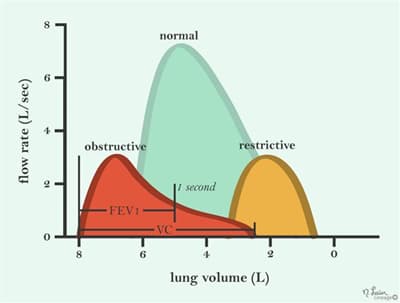
Introduction – Restrictive Lung Disease
- Definition
- restricted lung expansion
- results in reduced lung volumes (TLC and FVC)
- Pathophysiology
- poor breathing mechanics with normal lung function
- muscle weakness
- polio and myasthenia gravis
- chest wall limitation
- kyphosis, scoliosis, and morbid obesity
- ↓ pleural compliance
- mesothelioma
- muscle weakness
- interstitial lung diseases (diffuse parenchymal lung disease – DLCO)
- results in reduced lung compliance and increased elastic recoil
- the primary mechanism of resting hypoxemia in patients with interstitial lung disease is a diffusion limitation, with DLCO defect contributing to hypoxemia with activity
- increased expiratory flow rates due to increased radial traction (result of increased elastic recoil) on airway walls
- prevents small degree of dynamic collapse of conducting airways found in normal lungs
- poor breathing mechanics with normal lung function
results in ↓ in lung compliance and ↑ elastic recoil
no relative change in ventilation/perfusion because capillaries are destroyed along with alveolar units
- types
- acute
- acute interstitial pneumonia (AIP)
- presents similar to acute respiratory distress syndrome (ARDS)
- neonatal respiratory distress syndrome
- drug toxicity (bleomycin, busulfan, and amiodarone)
- acute interstitial pneumonia (AIP)
- chronic
- idiopathic interstitial pneumonias
- most common is idopathic pulmonary fibrosis (IPF)
- non-specific interstitial pneumonia, respiratory bronchiolitis, desquamative interstitial pneumonia, cryptogenic organizing pneumonia, and lymphocytic interstitial pneumonia
- pneumoconioses
- coal miner’s
- silicosis
- asbestosis
- sarcoidosis
- may also show obstructive or mixed pattern on PFT’s
- pulmonary Langerhans cell histiocytosis
- hypersensitivity pneumonitis (may be acute, subacute, or chronic)
- idiopathic interstitial pneumonias
- acute
- lymphangiomyomatosis (primarily young women)

Treatment
Restrictive lung disease is a group of lung disorders that limit the ability of the lungs to expand and fill with air, resulting in difficulty breathing. Treatment of restrictive lung disease focuses on managing symptoms and addressing the underlying cause of the condition. Here are some common treatments for restrictive lung disease:
- Oxygen therapy: Patients with restrictive lung disease may require supplemental oxygen to help maintain adequate oxygen levels in the blood.
- Medications: Depending on the underlying cause of the restrictive lung disease, patients may receive medications such as corticosteroids, immunosuppressants, or antibiotics.
- Pulmonary rehabilitation: Pulmonary rehabilitation is a program of exercise, breathing techniques, and education that helps patients with lung disease improve their breathing and overall physical function.
- Mechanical ventilation: In severe cases, patients with restrictive lung disease may require mechanical ventilation to help them breathe.
- Lung transplant: For some patients with severe restrictive lung disease, a lung transplant may be an option.
- Treatment of underlying conditions: If the restrictive lung disease is caused by an underlying condition, such as scoliosis or neuromuscular disease, treating that condition may improve lung function.
- Lifestyle modifications: Patients with restrictive lung disease may benefit from making certain lifestyle modifications, such as quitting smoking, avoiding exposure to lung irritants, and maintaining a healthy weight.
It’s important to work closely with a healthcare provider to develop a treatment plan that is tailored to the individual patient’s needs and goals. Regular follow-up visits and ongoing monitoring are important for managing symptoms and adjusting treatment as needed.
Studies
- Pulmonary function tests
- FEV1 sec/FVC ratio should be normal
- approximately normal because both FEV1 sec and FVC are reduced
- ↓ FVC and TLC
- key finding for restrictive lung diseases (TLC must be reduced)
- FEV1 sec/FVC ratio should be normal
There have been numerous studies conducted on restrictive lung disease in recent years, exploring the causes, risk factors, diagnosis, and treatment of this condition. Here are a few examples of recent studies:
- A study published in the European Respiratory Journal in 2020 found that treatment with pirfenidone, a medication used to treat idiopathic pulmonary fibrosis (a type of restrictive lung disease), was associated with improved lung function and reduced disease progression in patients with progressive fibrosing interstitial lung diseases.
- A study published in the American Journal of Respiratory and Critical Care Medicine in 2019 found that the use of high-flow nasal cannula oxygen therapy was associated with improved outcomes in patients with acute respiratory failure due to interstitial lung disease.
- A study published in the Annals of the American Thoracic Society in 2018 found that pulmonary rehabilitation was associated with improved quality of life and physical function in patients with interstitial lung disease.
- A study published in the Journal of Thoracic Disease in 2017 found that treatment with the medication nintedanib was associated with improved lung function and reduced disease progression in patients with idiopathic pulmonary fibrosis.
- A study published in the American Journal of Respiratory and Critical Care Medicine in 2016 found that the use of noninvasive ventilation was associated with reduced mortality rates in patients with acute exacerbations of interstitial lung disease.
These studies, among many others, provide valuable insights into the diagnosis and treatment of restrictive lung disease, and may help improve outcomes for patients with this condition.
Check out USMLE Success Strategy: Personalized Consultation and Study Plan Development.


